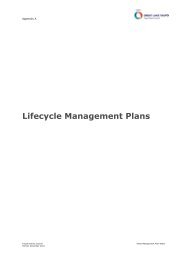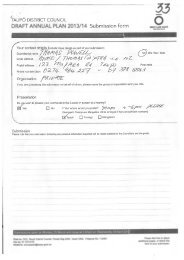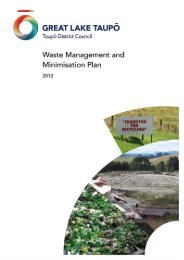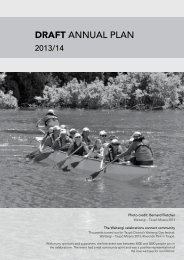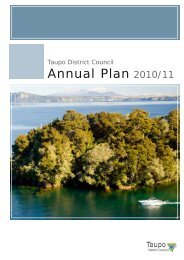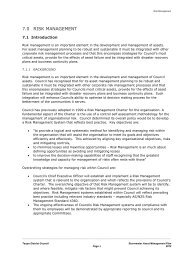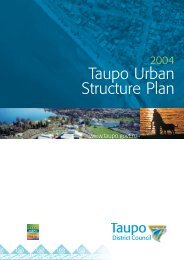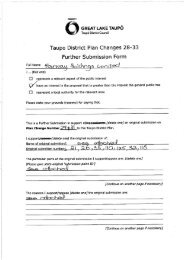Geotechnical Assessment - Taupo District Council
Geotechnical Assessment - Taupo District Council
Geotechnical Assessment - Taupo District Council
You also want an ePaper? Increase the reach of your titles
YUMPU automatically turns print PDFs into web optimized ePapers that Google loves.
The data gathered from the geotechnical and geo-environmental assessments is presented<br />
in Figures 2 to 7 in Appendix A. This data is available in Transverse Mercator 2000<br />
(TM2000) coordinates for inclusion into TDC’s GIS database. The geotechnical and geoenvironmental<br />
hazards associated with each area are summarised in Appendix B.<br />
<br />
<br />
<br />
<br />
The <strong>Taupo</strong> Volcanic Zone is an area of high active faulting although the thin crust limits<br />
maximum earthquake magnitudes 1 . Deposits of young volcanic and fluvial material often<br />
mask the surface expression of many faults in the <strong>Taupo</strong> area. No new faults were<br />
identified during our walkover, but various faults have been mapped that intersect with,<br />
or are proximal to the proposed industrial areas 1,2 . These are shown in Figures 3 to 5. The<br />
geothermal activity in the Broadlands and Crown Road reserves is associated with the<br />
Rotokawa Fault Zone 3 . A mapped splay of the recently active Aratiatia Fault also passes<br />
through one of the proposed industrial areas 1 .<br />
Mapped faults are located in or close to areas 3, 4, 6, 7 and 10. The eastern splay of the<br />
Aratiatia Fault runs through Area 10 and runs close to areas 3 and 4. A gully that runs<br />
through area 5 may also represent the extension of a fault mapped to the northeast 4 .<br />
<br />
<br />
The pumiceous deposits that are underlying the proposed industrial sites are usually<br />
highly permeable and any water that falls onto, or flows over them generally percolates<br />
away quickly. Zones of flood hazard have been identified in a number of places and<br />
comprise the floors of ‘box’ gully systems that dissect ground surface. These areas are<br />
usually dry, but are potential overland flow paths and as such are considered flood<br />
hazard zones. These gully systems are thought to have formed by erosion immediately<br />
after the deposition of the <strong>Taupo</strong> ignimbrite. They are dry, but are much lower than the<br />
surrounding countryside. Incised ‘box’ gullies are located in areas 1, 4, 7, and 8 (see<br />
Figures 3, 4 and 5). Potential flood hazard zones are also present in area 5 and 6 where<br />
shallow incised gullies are present.<br />
A significant flood hazard has been identified in Area 10 by TDC. This relates to<br />
stormwater runoff from the industrial area and roads to the east. Incised gullies are also<br />
present in to the north and west of Area 10 which are potential flood hazards.<br />
Numerous dry shallow stream channels can be observed in all of the areas studied. They<br />
are often of limited extent as any water flowing in them soaks away into the ground.<br />
These shallow channels are not considered to comprise a high flood risk, however, some<br />
of these channels were observed to contain freshly deposited material indicating recent<br />
overland water flow. They should be taken into account during development and<br />
appropriate drainage measures implemented.<br />
1 McVerry et al. (2005) Estimation of spectra for Waikato River Bridge, East <strong>Taupo</strong> Bypass. Report by GNS<br />
Science to Opus International Consultants.<br />
2 Grindley, G.W. (1961) Geological Map of New Zealand, 1:63,360, Sheet 8 – <strong>Taupo</strong>, New Zealand Geological<br />
Survey.<br />
3 Fulton Hogan (2008) <strong>Taupo</strong> <strong>District</strong> <strong>Council</strong> Contract No. TDC 678 East <strong>Taupo</strong> Arterial. Tender Submission<br />
Report<br />
4 Terrane Consultants (2008) <strong>Taupo</strong> Retail Holdings, Broadlands Road <strong>Geotechnical</strong> Peer Review Report.



